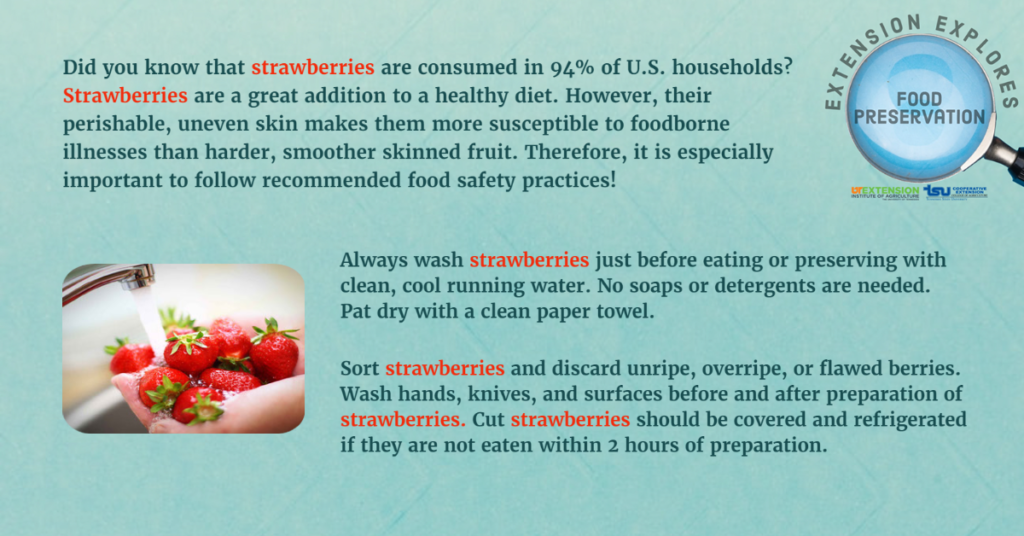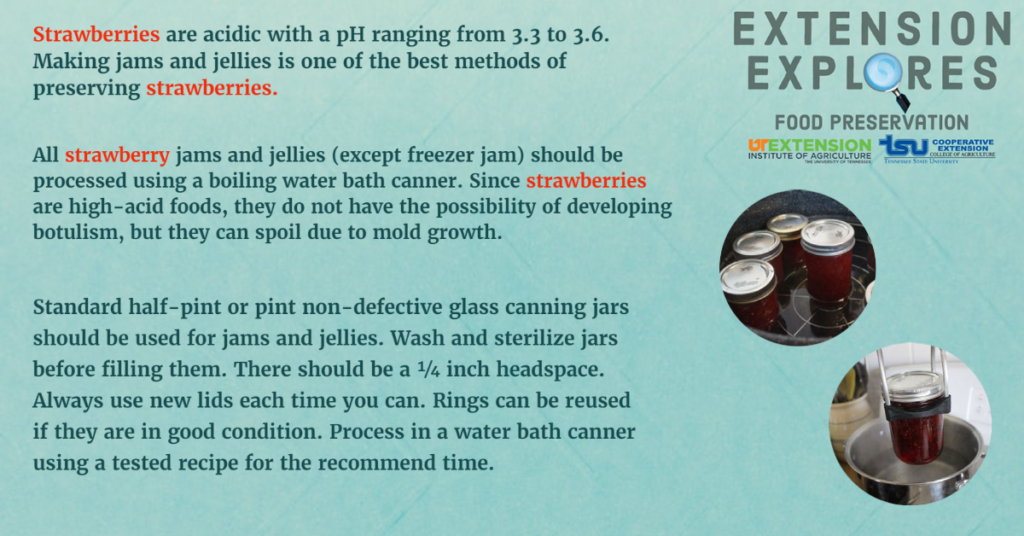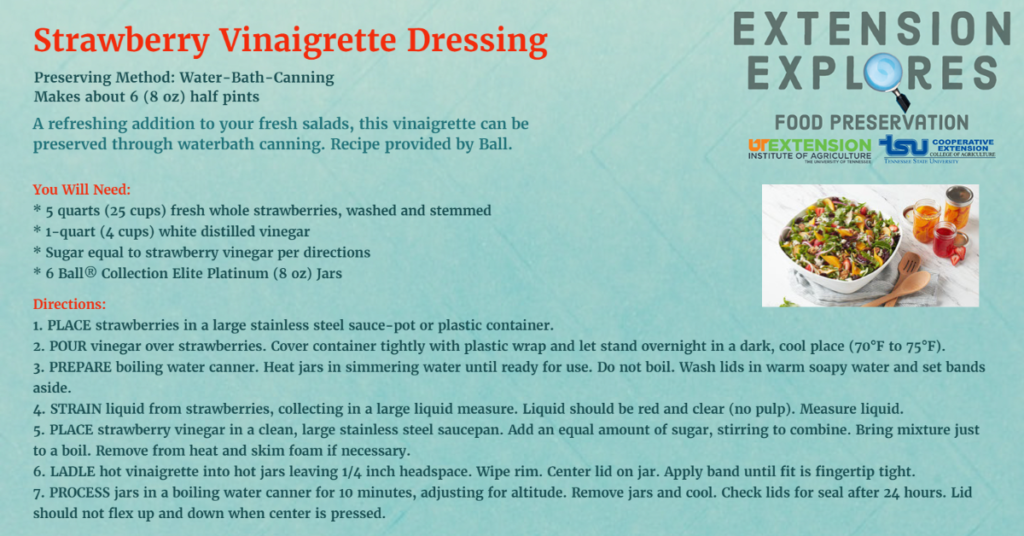
Late spring is a sweet time in middle Tennessee if you love the taste of strawberries. While enjoying a fresh bowl of strawberries or your favorite strawberry enhanced dessert is wonderful, let’s take it a step further and preserve some strawberries to have when they are not in season.
Here’s a closer look at strawberries.
Tip # 1 – Selection is key. Handle fresh strawberries safely –Choose strawberries that have a bright, even, red color (strawberries will not ripen anymore after picking), a fresh aroma and an intact, healthy green cap.
Avoid strawberries that are poorly colored with white or green areas, are mushy, damaged, leaking juice, shriveled or moldy or have dry brown caps
To prevent spoilage and mold growth during storage, it is best to wash them just before they are prepared. Place the strawberries in a clean and sanitized colander and remove any damaged fruit. Wash the strawberries under clean, running water using a kitchen sink sprayer if possible. If you don’t have a sprayer, wash, turn, and gently shake the berries under slow running water. Do not soak berries. Do not use detergents, soaps or bleach to wash fresh strawberries as it may change the taste of the fruit and could be poisonous.
Tip # 2 – Decision time – to freeze, can or dry? Strawberries can be either frozen or made into delicious jams, jellies, and preserves and even dried. How you intend to use the strawberries later can determine whether to freeze or preserve. Frozen strawberries work well in baking, smoothies, or eating as a topping (over yogurt) for example. Strawberries (and other fruits & vegetables) maintain their quality when frozen for 8 – 12 months. After 12 months, they are still safe, just lower in quality. For best quality, use them by about 8 months.
Tip #3 – You may choose to make strawberry jam, jelly, or preserves. Using tested recipes is needed for the safety of the processed food. Information concerning safe canning methods and recipe resources is linked below or check with your local Extension office for more information.
Tip # 4 – Strawberries are a fair to good choice for drying and an excellent choice for making fruit leathers. Drying preserves the food so that bacteria, yeasts, and molds cannot grow and spoil the food. It also slows down the action of enzymes, but does not inactivate them. Fruits may be dried out-of-doors or indoors depending on your preference. High humidity can cause issues with drying out-of-doors. A humidity below 60% is best. If humidity is above 60% other alternatives to drying are needed. No pretreatment is necessary for drying strawberries. Please check with your local Extension office for more information.
Tip # 5 – Some commonly asked questions and answers:
What temperature should my freezer be? Freeze foods at 0 degrees or lower.
Will berries ripen after picking? No. Once berries are picked they will not ripen. Search for berries with the red color instead of white or green areas.
Do berries have to be the same size? While same size berries might be enticing to eat, it’s fine to use the smaller or irregular shaped berries as well in preserving. They may even tend to be a little sweeter.
Can I use paraffin to seal my preserves? Paraffin or wax seals are no longer recommended because of possible mold contamination.
Which jar should I use? Mason-type jars specifically designed for home canning are best.
Whether you choose freezing, canning or drying, strawberries can be enjoyed throughout the year.
Canning Recipes:
- Strawberries become mushy and lose color when canned so it is not recommended. Instead make a syrup or soft spread or freeze the berries.
- Strawberry Syrup
- Strawberry Jelly with Powdered Pectin
- Strawberry Jelly with Liquid Pectin
- Strawberry Rhubarb Jelly with Liquid Pectin
- Strawberry Jam with No Pectin (Long Cook)
- Strawberry Jam Variations: Vanilla, Lemon, Peppered
- Strawberry Jam with Powdered Pectin
- Homemade Strawberry Jam with Powdered Pectin
- Strawberry Balsamic Jam with Powdered Pectin
- Strawberry Jam with Low/No Sugar Pectin
- Strawberry Kiwi Jam with Powdered Pectin
- Strawberry Rhubarb Jam with Powdered Pectin
- Mixed Berry Jam with Powdered Pectin
- Strawberry Preserves
- Strawberry Lemon Marmalade
- Strawberry Honey Butter
Freezing Recipes:
- Freezing Strawberries with Sweetened Packs
- Freezing Strawberries with Dry Pack
- Freezing Strawberries with Pectin Pack
- Freezer Jam with Powdered Pectin
- Freezer Jam with Liquid Pectin
- Low Sugar Strawberry Freezer Jam
- No Sugar Strawberry Freezer Jam
Videos:
- Extension Explores: Preserving Strawberries Zoom Session from May 2021
- Using a Waterbath Canner Slide Presentation (Tennessee Extension)
- Using a Waterbath Canner (Georgia Extension)
- Making Strawberry Jam with Powdered Pectin (Tennessee Extension)
- Making Strawberry Jam with Powdered Pectin (Illinois Extension)
- Freezing Strawberries (Illinois Extension)
Other Recipes:
Resources:
- Strawberries Produce Page
- Extension Explores: Preserving Strawberries Digital Newsletter 2022
- Let’s Preserve Strawberries (Penn State Extension)
- Freezing Strawberries (Penn State Extension)
- Preserving Strawberries (Kansas Extension)
- Strawberry Basics – Selecting/Freezing (Clemson Extension)
- Strawberries, Strawberries, Strawberries (Clemson Extension)
- Using, Storing and Preserving Strawberries (Michigan Extension)
- How to Use a Waterbath Canner
- How to Remake Jams and Jellies
- Remaking Cooked and Uncooked Jams and Jellies (Oregon Extension)
- How to Stop Strawberry Jam from Separating (Michigan Extension)




For more information or questions about food preservation, please contact the Family and Consumer Sciences Agent at your local county Extension office. Click here for a list of the Tennessee Extension Offices.
Trade and brand names are used only for information. The University of Tennessee Extension and Tennessee State University Extension do not guarantee nor warrant published standards on any product mentioned; neither does the use of a trade or brand name imply approval of any product to the exclusion of others which may also be suitable.